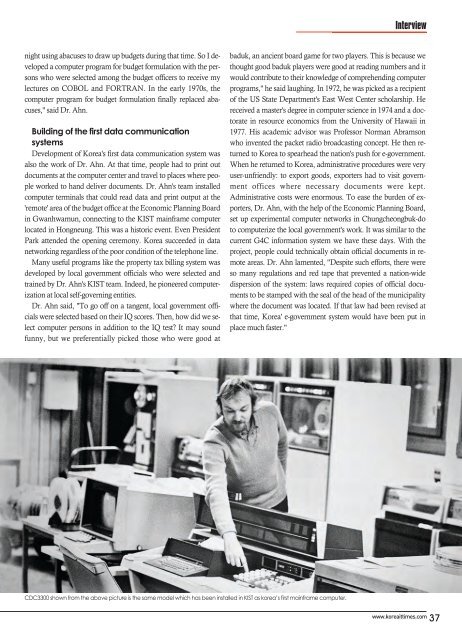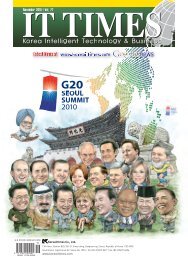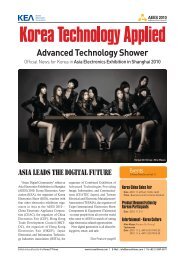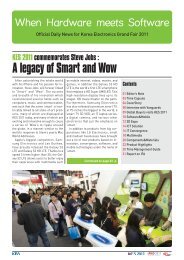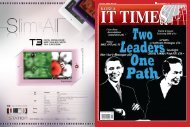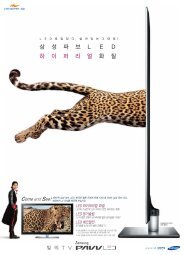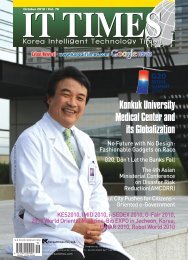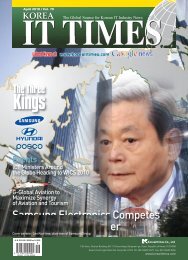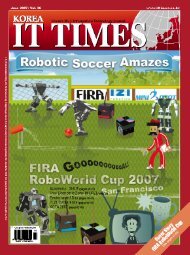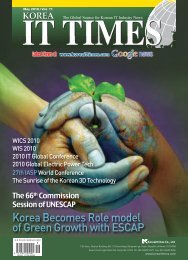Create successful ePaper yourself
Turn your PDF publications into a flip-book with our unique Google optimized e-Paper software.
Interview<br />
night using abacuses to draw up budgets during that time. So I developed<br />
a computer program for budget formulation with the persons<br />
who were selected among the budget officers to receive my<br />
lectures on COBOL and FORTRAN. In the early 1970s, the<br />
computer program for budget formulation finally replaced abacuses,"<br />
said Dr. Ahn.<br />
Building of the first data communication<br />
systems<br />
Development of <strong>Korea</strong>'s first data communication system was<br />
also the work of Dr. Ahn. At that time, people had to print out<br />
documents at the computer center and travel to places where people<br />
worked to hand deliver documents. Dr. Ahn's team installed<br />
computer terminals that could read data and print output at the<br />
'remote' area of the budget office at the Economic Planning Board<br />
in Gwanhwamun, connecting to the KIST mainframe computer<br />
located in Hongneung. This was a historic event. Even President<br />
Park attended the opening ceremony. <strong>Korea</strong> succeeded in data<br />
networking regardless of the poor condition of the telephone line.<br />
Many useful programs like the property tax billing system was<br />
developed by local government officials who were selected and<br />
trained by Dr. Ahn's KIST team. Indeed, he pioneered computerization<br />
at local self-governing entities.<br />
Dr. Ahn said, "To go off on a tangent, local government officials<br />
were selected based on their IQ scores. Then, how did we select<br />
computer persons in addition to the IQ test? It may sound<br />
funny, but we preferentially picked those who were good at<br />
baduk, an ancient board game for two players. This is because we<br />
thought good baduk players were good at reading numbers and it<br />
would contribute to their knowledge of comprehending computer<br />
programs," he said laughing. In 1972, he was picked as a recipient<br />
of the US State Department's East West Center scholarship. He<br />
received a master's degree in computer science in 1974 and a doctorate<br />
in resource economics from the University of Hawaii in<br />
1977. His academic advisor was Professor Norman Abramson<br />
who invented the packet radio broadcasting concept. He then returned<br />
to <strong>Korea</strong> to spearhead the nation's push for e-government.<br />
When he returned to <strong>Korea</strong>, administrative procedures were very<br />
user-unfriendly: to export goods, exporters had to visit government<br />
offices where necessary documents were kept.<br />
Administrative costs were enormous. To ease the burden of exporters,<br />
Dr. Ahn, with the help of the Economic Planning Board,<br />
set up experimental computer networks in Chungcheongbuk-do<br />
to computerize the local government's work. It was similar to the<br />
current G4C information system we have these days. With the<br />
project, people could technically obtain official documents in remote<br />
areas. Dr. Ahn lamented, "Despite such efforts, there were<br />
so many regulations and red tape that prevented a nation-wide<br />
dispersion of the system: laws required copies of official documents<br />
to be stamped with the seal of the head of the municipality<br />
where the document was located. If that law had been revised at<br />
that time, <strong>Korea</strong>' e-government system would have been put in<br />
place much faster."<br />
CDC3300 shown from the above picture is the same model which has been installed in KIST as korea’s first mainframe computer.<br />
www.koreaittimes.com 37


